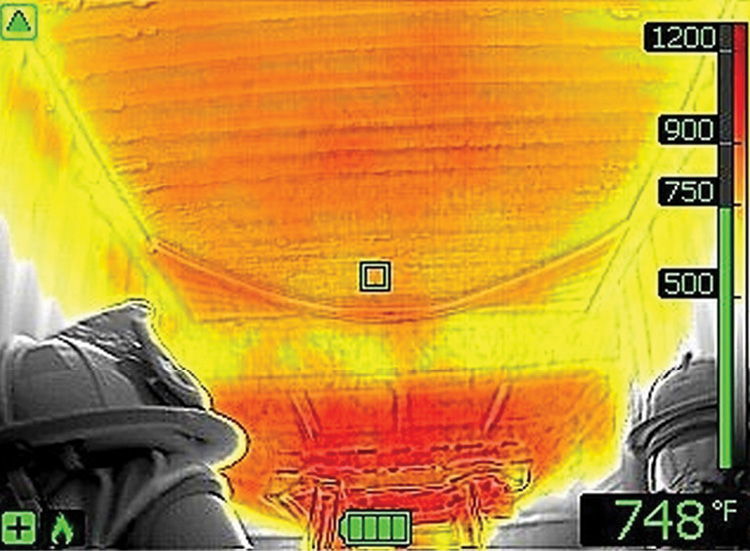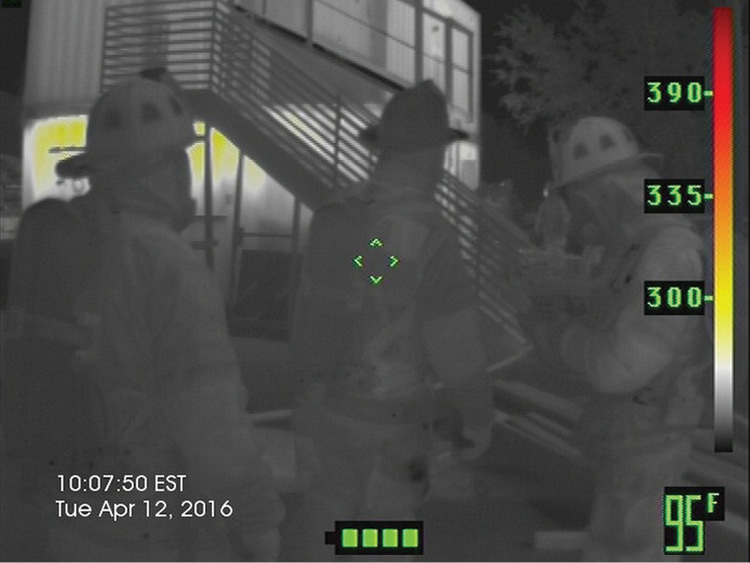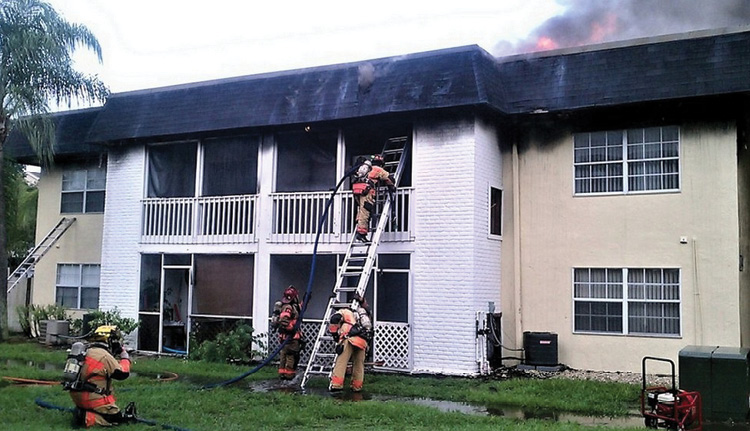TRAINING NOTEBOOK ❘ By JOE DeVITO
In the fire service, thermal imaging has been simplified to just “look at the wall and find the hot spots.” Although this is true in one instance (“put the wet stuff on the red stuff”), the way we perform a task affects the way we perform our next task. However, this article is not about tactics; it’s about different uses for the thermal imaging camera (TIC) and why thermal imaging is more than just looking for the hot spots and no longer just for overhaul.

(1) Use your thermal imaging camera (TIC) to locate the flow path, to consider cooling, and as a guide to find the fire. (Photos by author.)

(2) Instead of just spraying water all over the room, use the TIC to locate the base of the fire.
Size-Up Scenario
When responding to any fire, the objective is to save life and property. The easiest way to do that is to know the fire’s location before you enter; then enter and put it out. A method of gathering the information to determine a fire’s location is to use a TIC during your size-up.
The 360°. Start on the Alpha side of the structure and scan it for heat signatures. Then, open the front door and do a quick scan for conditions and victims. You may find victims by the door, so make the grab while checking for other victims. Next, close the door and continue your size-up. If the area around the window has a thermal “clue” on the right of the Alpha side, continue your size-up on the Delta side where the heat appears to be. Now, you see heat signatures on the left of the Delta side wall; the heat then decreases as you continue down the Delta side toward the Charlie side, which shows no heat. You then scan the Charlie side with your TIC when you come to a door. The door is unlocked and shows no signs of heat. Open the door and do a quick scan for victims. If no victims are by the door or in the scan, close the door and continue your size-up down the Charlie side toward the Bravo side. The Bravo side is clean, and you return to the Alpha side where you started. You then check the initial heat area for more involvement, higher temps, or heat signatures lower on the wall to show a neutral plane drop. This size-up informs you to make entry and head toward the Alpha-Delta corner of the structure for rapid fire extinguishment.
Flow path. Now inside and heading toward the Alpha-Delta corner, you see the convection waves coming from your right-hand side. This is a sign of a fire flow path; you see convection speed, neutral plane, and convection temperatures, and you can locate cold spots. You now read your conditions based off of the thermal data and choose to continue or condition (cool) before moving on. Condition the environment and continue the search.
Search. Next, you find a bedroom and use the TIC to scan for conditions and victims. Keep in mind that there may be “thermal conversion,” best described as that which is the hottest outside but not the hottest inside; it is based on the environment, not the item. On the truck room floor, the TIC presents you as being the brightest object because you are the hottest object in the room. In the fire room, however, the TIC may now show you as dark gray because the room is warmer than you are.
To save time and energy, you need only to search the areas you cannot see with the TIC. Look under the bed, under the covers, and in the closet. Remember to look for objects that you cannot identify such as a big lump on the bed; that lump could be a child hiding under the blanket that acts as an insulator, which would not let the heat escape and be visible on the TIC. The room is clear; exit and shut the door.
As you continue down the hall toward the fire, the thermal conditions are deteriorating. You can read a drop in the neutral plane, increased temperatures in the convection, and visual conditions darkening down. You can now use the tool; your knowledge of fire behavior tells you that you need to condition the area around you to prevent thermal insult to yourself and prevent flashover conditions.

(3) Use the TIC to look for the built-up heat area and for the location of the flow path. Use this information to determine the structure’s entry point and to find the survivable areas.
RELATED
Aerial Thermal Imaging Aids Fireground Strategy
In the Fire Room
Nozzle patterns. Where should you aim the water to extinguish the fire? With ventilation-limited fires, many times you cannot see the base of the fire when you need to employ your nozzle patterns. With the TIC, you can locate the base of the fire and hit it with your stream for extinguishment, causing less steam conversion and quicker extinguishment by cooling materials to below flammable limits.
Ventilation. When you get water on the fire and there is a call for ventilation, use the TIC to locate the area that contains the most heat. In vertical ventilation, look at the roof and find the heat signatures. Always open the roof as close to the fire as possible; this method will assist with ventilation and help control the heat’s release direction and unburned fuels.
Overhaul. This is where the need for the TIC began: search and overhaul. Although this is the original purpose of the TIC, it is no longer just for overhaul. Look for heat signatures hidden in the walls and check around the window and door frames; this will decrease damage and preserve evidence if needed.
Nonfire Applications
We know about the TIC’s fire scene applications, but we can also use it on several other response types as well, some of which follow:

(4) Use your TIC to assess the room, the roof, and the floor below prior to performing vent-enter-isolate-search.
Electrical. Scenario: The tones drop for the smell of something burning inside a residence. When you enter the structure, you recognize that smell—electrical overheating. The first place you should look is at the fuse panel. Use the TIC to look for fuses that are blown or with high-heat signatures. When you see the high-heat signatures on the fuses, find which fuse it belongs to and investigate that area. This will save time, effort, and maybe even property.
Motor vehicle accidents (MVAs). There are several ways you can use a TIC at an MVA, most commonly for matching seats to sitters. The seat in which you sit cannot produce its own heat, but it can absorb heat from an object and then give it off when collected. When scanning car seats, you can see how many occupants were in the vehicle, and you can compare this information to the number of patients you have at the scene. Some examples where this will come into play are at a rollover with ejection and an MVA with an unconscious or unreliable patient.
Outdoor searches. The TIC can be useful in incidents such as 2013’s Boston Marathon bombing, which used thermal imaging to find a suspect hiding in a boat. Remember, you cannot see through objects like walls, trees, or water. For a water rescue, look for heat signatures on the surface and investigate from there. Because the TIC cannot see through water, if this is not a surface water rescue, you will not see the victim.
Hazmat. With a TIC, you can see levels of fluid inside a container or the baffles inside a train or truck. In a fluid spill, you can see splash marks to prevent contamination or flow direction to contain a spill. If the hazardous material is in the water but it has a specific gravity of less than “1,” you can see the material floating on the water. This is important to see the direction and extent of spread. If there is a puncture of a gas container, there will be an endothermic or exothermic reaction, and the TIC could locate the puncture.
 |
 |
(5, 6) Locate your electric, gas, and propane, and do not forget to turn off the generators.
Forest/brush fires. For these responses, use the TIC to avoid oncoming traffic in smoke, for reading street signs, and for looking at terrain. Also, use it to spot firefighters, animals, and citizens. Fire location and direction are now being seen from above with thermal drones, which help find areas that may assist with roads and rivers. It can also help locate structures that may be threatened. Another big assist is looking for hot spots. Without a TIC, firefighters need to stir the brush to find heat; with a TIC, it will save time and energy.
You can use a TIC for many applications on a fire scene. Like any other skill, it takes a lot of practice. The more normal thermographs you see, the more likely you will see an anomaly. Thermal imaging is a great tool that, when used properly and in conjunction with our firefighting knowledge and experience, greatly enhances our capabilities.
Joe DeVito is a 20-plus-year public service veteran and a captain and paramedic with the Fort Myers Beach (FL) Fire Department, where he has been a member for 12 years. He has worked at volunteer organizations and as an EMT-P for a county-run emergency medical services (EMS) department. DeVito is also a Florida fire and EMS instructor, certified to level 1 thermography, and is a member of Kill the Flashover and Florida Gulf Coast FOOLS.

